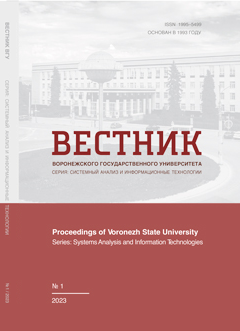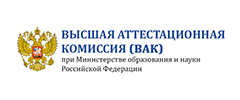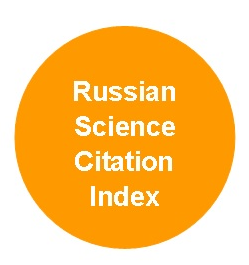Онтологическая модель почти периодического анализа данных с упорядоченным аргументом
Аннотация
Рассмотрены основные термины, взаимосвязи и принципы почти периодического анализа и обработки нелинейных данных с упорядоченным аргументом, в которых выявление чистых периодов не представляется возможным. Для описания основных связей почти периодического анализа были построены онтологические модели, позволяющие описывать взаимодействие ресурсов и структур данных. Предложены онтологические модели отношения основных терминов почти периодического анализа, представлено взаимодействие между процессами при использовании данного подхода к анализу временных рядов и фото- и видеоматериалы тропических циклонов. На основе предложенных онтологий была построена диаграмма классов, описывающая структуру связей и иерархии классов реализованной программы почти периодического анализа для взаимодействия с пользователем, предоставляя ему удобный пошаговый функционал по обработки данных. Приведено описание последовательности обработки данных временных рядов, медиаданных, и выявления в них почти периодических компонент. В качестве практической реализации предлагаемого подхода был проведен анализ изображений тропических циклонов из открытых источников и временного ряда ежегодных данных по циклонической энергии тайфунов. Продемонстрированы возможности отображения, полученных по результатам почти периодического анализа значений характерных зон тайфуна, что позволяет не только структурно разделить исследуемое опасное природное явление на зоны его взаимодействия в пространстве, но и сделать прогноз динамики его развития. Прогнозные оценки ежегодной циклонической энергии позволили выдвинуть предположение о характерном экстремуме данных во второй половине 2030-х годов, который изменит текущую ежегодную тенденцию динамики накопленной энергии тропических циклонов.
Скачивания
Литература
2. Kalach A. V., Nicheporchuk V. V. and Baturo A. N. (2021) Decision-making support in flood protection of territories. Bulletin of Voronezh State University. Series: Systems Analysis and Information Technologies. 1. P. 74–86. DOI
3. Gorokhov M. M. and Kurguzkin P. M. (2024) Building an information-logical model for ecological monitoring of natural-technical systems. Intelligent Systems in Manufacturing. 22(2). P. 41– 48. DOI
4. Gorokhov M. M., Kurguzkin P. M. and Korepanov M. A. (2023) Methodological aspects of assessing the state of local natural-technical systems based on ecological monitoring. Intelligent Systems in Manufacturing. 21(3). P. 54–61. DOI
5. Lapshin V. A. (2010) Ontologies in computer systems. Moscow : Nauchny Mir.
6. Begler A. and Kondratyev K. (2023) Data-centric architecture: Flexible data handling. Open Systems. DBMS. 3. P. 19–23. DOI
7. Yarullin D. V. (2022) Intelligent system for IT specialist training based on denotative analytics. Applied Mathematics and Management Issues. 3. P. 141–164. DOI
8. Certificate of State Registration for Software No. 2024666026 Russian Federation, 2024. Ontological model for automated data replenishment for applied photogrammetry systems synthesis: Application No. 2024664694, filed on 28 June 2024, published on 9 July 2024. A. V. Kozlovsky and V. I. Voloshchuk; applicant: Southern Federal University.
9. Certificate of State Registration for Software No. 2022680456 Russian Federation, 2022. Testing module with artificial intelligence elements based on ontologies OntoMentor: Application No. 2022669808, filed on 24 October 2022, published on 1 November 2022. V. I. Khabarov, I. S. Volegzhanina, E. M. Volegzhanina and R. I. Makarov; applicant: Siberian State Transport University.
10. Chernyshova G. Y. and Repening, P. A. (2022). Building decision support systems based on ontological models. Information Technologies in Education. 5. P. 270–274.
11. Losev V. S. and Goncharuk N. V. (2020) Ontology as a tool for developing semantic knowledge representation processes. Scientific Aspect. 4(4). P. 465–470.
12. Wilson R. S. I., Goonetillake J. S., Indika W. A. and Ginige A. (2023) A conceptual model for ontology quality assessment. Semantic Web, (Preprint). P. 1–47.
13. Qiu Q., Xie Z., Zhang D., Ma K., Tao L., Tan Y., Zhang Z. and Jiang B. (2023) Knowledge graph for identifying geological disasters by integrating computer vision with ontology. Journal of Earth Science. 34(5). P. 1418–1432.
14. Malakhov K., Petrenko M. and Cohn E. (2023) Developing an ontology-based system for semantic processing of scientific digital libraries. South African Computer Journal. 35(1). P. 19–36.
15. Chen D., Zheng Y., Ma L. and Qin F. (2023) An ontology-based knowledge representation method for typhoon events from Chinese news reports. ISPRS International Journal of Geo-Information. 12(9). P. 383.
16. Cvetković V. M., Renner R., Aleksova B. and Lukić T. (2024) Geospatial and temporal patterns of natural and man-made disasters (1900–2024): Insights from socio-economic and demographic perspectives. Applied Sciences. 14(18). P. 8129.
17. Chen A., Huang H., Wang J., Li Y., Chen D. and Liu J. (2023) An analysis of the spatial variation of tropical cyclone rainfall trends in Mainland Southeast Asia. International Journal of Climatology. 43(13). P. 5912–5926.
18. Hao P., Zhao Y., Li S., Song J. and Gao Y. (2024) Deep learning approaches in predicting tropical cyclone tracks: An analysis focused on the Northwest Pacific region. Ocean Modelling. P. 102444.
19. Garner A. J. (2023) Observed increases in North Atlantic tropical cyclone peak intensification rates. Scientific Reports. 13(1). P. 16299.
20. Song J. Y. and Chung E. S. (2024) Increasing wind threat of Atlantic tropical cyclones: A comprehensive risk analysis using multi-hazard hurricane and social vulnerability indexes. Earth Systems and Environment. P. 1–12.
21. Jaiswal N., Jishad M., Deb S. K., Varma A. K., Agarwal N. and Sharma R. (2023) Analysis of atmospheric and oceanic conditions during unusual occurrence of tropical cyclone Gulab and Shaheen in North Indian Ocean. Journal of Earth System Science. 132(3). P. 109.
22. Liu Z., Carr M. L., Nadal-Caraballo N. C., Aucoin L. A., Yawn M. C. and Bensi M. T. (2024) Comparative analysis of joint distribution models for tropical cyclone atmospheric parameters in probabilistic coastal hazard analysis. Stochastic Environmental Research and Risk Assessment. 38(5). P. 1741–1767.
23. Ricciardulli L., Howell B., Jackson C. R., Hawkins J., Courtney J., Stoffelen A., Langlade S., Fogarty C., Mouche A., Blackwell W. and Meissner T. (2023). Remote sensing and analysis of tropical cyclones: Current and emerging satellite sensors. Tropical Cyclone Research and Review. 12(4). P. 267–293.
24. Duong Q. P., Wimmers A., Herndon D., Tan Z. M., Zhuo J. Y., Knaff J., Al Abdulsalam I., Horinouchi T., Miyata R. and Avenas A. (2023) Objective satellite methods including AI algorithms reviewed for the tenth International Workshop on Tropical Cyclones (IWTC-10). Tropical Cyclone Research and Review. 12(4). P. 259–266.
25. Paramonov A. A., Krynetsky B. A. and Smolentseva T. E. (2024) Practical significance of near-periodic analysis. Proceedings of the International Symposium “Reliability and Quality”. Vol. 1. P. 227–230.
26. Certificate of State Registration for Software No. 2024663550 Russian Federation, 2024. Program for determining quasi-periods in empirical data with an ordered argument based on a shift function: Application No. 2024661738, filed on 21 May 2024, published on 7 June 2024. Krynetsky B. A., Danilova V. A., Paramonov A. A. and Smolentseva T. E.
27. Paramonov A. A. and Krynetsky B. A. (2024) Near-periodic analysis of global monthly temperature anomaly. 2024 4th International Conference on Technology Enhanced Learning in Higher Education (TELE), Lipetsk, Russian Federation. P. 135–138. DOI
28. Kalach A. V., Malygin I. G. and Paramonov A. A. (2024). Quasi-periodic analysis of accumulated typhoon energy in the study of emergencies caused by tropical cyclone activity. Risk Management Problems in the Technosphere. 3. P. 55–62. DOI
29. Kuzmin V. I., Gadzaov A. F. and Dzerjinsky R. I. (2021) Methods for Data Analysis. Moscow : Pero Publishing House. 243 p.
- Авторы сохраняют за собой авторские права и предоставляют журналу право первой публикации работы, которая по истечении 6 месяцев после публикации автоматически лицензируется на условиях Creative Commons Attribution License , которая позволяет другим распространять данную работу с обязательным сохранением ссылок на авторов оригинальной работы и оригинальную публикацию в этом журнале.
- Авторы имеют право размещать их работу в сети Интернет (например в институтском хранилище или персональном сайте) до и во время процесса рассмотрения ее данным журналом, так как это может привести к продуктивному обсуждению и большему количеству ссылок на данную работу (См. The Effect of Open Access).



















